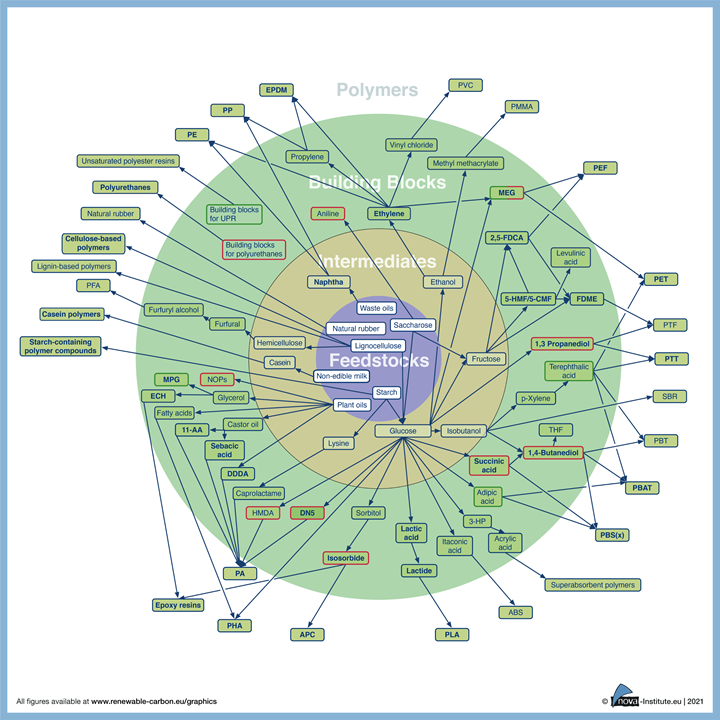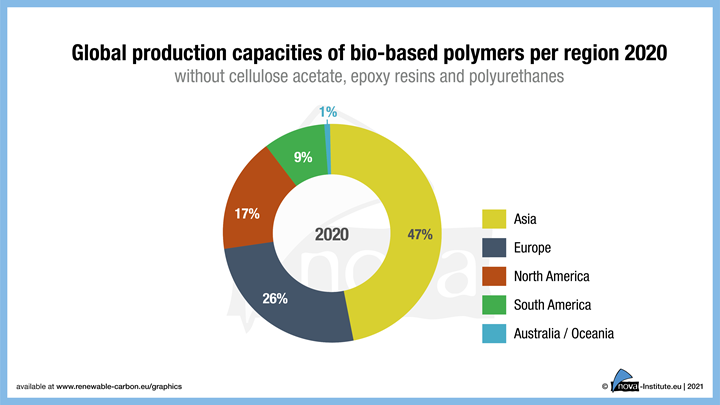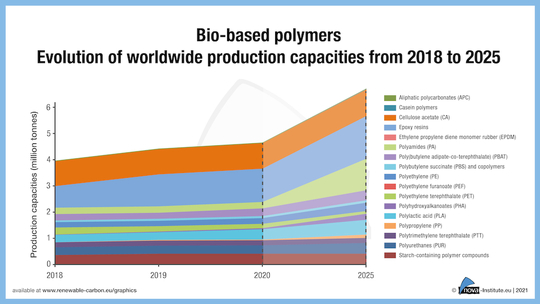Growth Rate of Bioplastics Higher than Overall Plastics Market Growth
nova-Institute reports that the for the first time, the growth rate of biobased polymers exceeds that of the overall plastics market growth.
A new market and trend report from German-based researcher nova-Institute characterizes the year 2020 as very promising for biobased polymers. Sold-out PLA in 2019 led to the installation of increased capacities, PE and PP made from biobased naphtha are breaking ground, and future expansion for biobased polyamides/nylons as well as for PBAT, PHAs and casein polymers is on the horizon. A lower production was only observed for biobased PET.
“Bio-based Building Blocks and Polymers – Global Capacities, Production and Trends 2020–2025” from the international nova biopolymer expert group shows capacities and production data for all biobased polymers in the year 2020 and a forecast for 2025.

Several global brands are already expanding their feedstock portfolio to include, next to fossil-based, sources of renewable carbon, CO2, recycling and especially biomass, increasing the demand for biobased as well as biodegradable polymers. Nevertheless, at the same time, there is a lack of support from politics, which still only promotes biofuels and bioenergy.
In 2020, the total production volume of biobased polymers was 4.2 million tonnes, which is 1 % of the total production volume of fossil-based polymers. For the first time in many years, the CAGR of 8% is significantly higher than the 3-4% of the overall growth of polymers, and this is expected to continue until 2025.
Overall, the global land requirement for bio-based polymers is only 0.006 % of the global agricultural land. The major biomass feedstock used for bio-based polymer production is glycerol as a biogenic by-product (37 %).
In the annually updated market report for the year 2020, a total of 17 biobased building blocks and 17 polymers are described, in addition to comprehensive information on the capacity development from 2020 to 2025 and production data for 2020 per bio-based polymer. Furthermore, the issue includes analyses of market developments and producers per building block and polymer, so that readers can quickly gain a comprehensive overview of current developments that goes far beyond capacity and production figures. As an additional bonus the report provides a detailed, comprehensive expert view on biobased naphtha. Finally, the deep insight into manufacturing companies introduced in 2018 has been comprehensively updated and now shows 174 detailed company profiles – from startups to multinational corporations.

It is interesting to note that the increase in production capacity from 2019 to 2020 is mainly based on the expansion of PLA and PBAT production in Asia and the worldwide epoxy resin production. Also, increased and new production capacities for polybutylene succinate and copolymers (PBS(X)) and biobased PE and polyurethanes were reported in 2020. Especially polyamides/nylons and PP will continue to grow significantly (about 36 %) until 2025. While capacities for PHA will grow in Asia and North America, casein polymers in Europe will increase by 32 % until 2025, followed by increases in PE in South America and Europe, PLA mainly in Europe and PBAT in Asia with about 8%.
The data published annually by European Bioplastics () are taken from the market report written by biopolymer expert group of the nova-Institute, but with a smaller selection of biobased polymers. The corresponding authors are from Asia, Europe and North America.

Related Content
Flame-Retardant PP Compounds
Sirmax North America now offers a broad range of these compounds within three key product families
Read MoreMasterbatches Reduce Gloss in PLA and PETG 3D Printed Products
Insight Polymers & Compounding’s two low-gloss additive masterbatches shown to boost appearance of 3D printed objects.
Read MoreResearch Deems Bioplastics, Wood Pulp a Sustainable, Economic Alternative for Rigid Packaging
Farrel Pomini and FPInnovations produce biodegradable compound for molding, extrusion and thermoforming applications.
Read MoreHow Yeast Could Give Rise to Bioplastic
Researchers work to scale up a biomanufacturing process for succinic acid, an important building block for industrial chemicals and a biopolymer precursor.
Read MoreRead Next
Making the Circular Economy a Reality
Driven by brand owner demands and new worldwide legislation, the entire supply chain is working toward the shift to circularity, with some evidence the circular economy has already begun.
Read MorePeople 4.0 – How to Get Buy-In from Your Staff for Industry 4.0 Systems
Implementing a production monitoring system as the foundation of a ‘smart factory’ is about integrating people with new technology as much as it is about integrating machines and computers. Here are tips from a company that has gone through the process.
Read MoreBeyond Prototypes: 8 Ways the Plastics Industry Is Using 3D Printing
Plastics processors are finding applications for 3D printing around the plant and across the supply chain. Here are 8 examples to look for at NPE2024.
Read More













